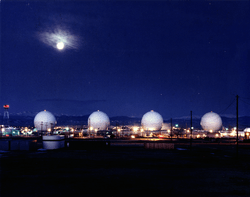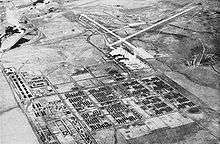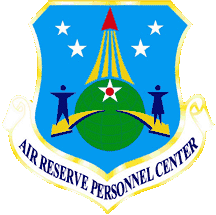Buckley Air Force Base
Buckley Air Force Base (IATA: BFK, ICAO: KBKF, FAA LID: BKF) is a United States Air Force base in Aurora, Colorado, that was established by the U.S. Army as an auxiliary field and bombing range in 1938, and activated as a designated installation in 1941. The base was named in honor of World War I Army pilot First Lieutenant John Harold Buckley.
| Buckley Air Force Base | |||||||
|---|---|---|---|---|---|---|---|
| Aurora, Colorado in the United States of America | |||||||
 Radomes protecting satellite dishes and other space operations equipment at Buckley Air Force Base. | |||||||
 Buckley AFB Location in the United States | |||||||
| Coordinates | 39°42′06″N 104°45′06″W | ||||||
| Type | US Space Force Base | ||||||
| Site information | |||||||
| Owner | Department of Defense | ||||||
| Operator | United States Space Force | ||||||
| Controlled by | 460th Space Wing | ||||||
| Website | www.buckley.af.mil | ||||||
| Site history | |||||||
| Built | 1938 (as Lowry Demolition and Bombing Range) | ||||||
| In use | 1938 – present | ||||||
| Garrison information | |||||||
| Current commander | Colonel Devin R. Pepper | ||||||
| Garrison | 460th Space Wing (Host) | ||||||
| Occupants |
| ||||||
| Airfield information | |||||||
| Identifiers | IATA: BFK, ICAO: KBKF, FAA LID: BKF, WMO: 724695 | ||||||
| Elevation | 1,726.1 metres (5,663 ft) AMSL | ||||||
| |||||||
| Source: Federal Aviation Administration[1] | |||||||
Buckley Air Force Base is assigned to Space Operations Command (formerly the Fourteenth Air Force) and serves more than 92,000 active duty, National Guard, Reserve and retired personnel throughout the Front Range community. The host unit is the 460th Space Wing. Buckley AFB supports air operations, space-based missile warning capabilities, space surveillance operations, space communications operations and installation support functions.[2]
History
World War II
In 1938, the city of Denver purchased a 100-square mile area of land several miles east of the city and donated it to the War Department. Initially, it was called the Demolition Bombing Range and served as an auxiliary field, ordnance loading area, and practice range for bombers from nearby Lowry Field. On June 14th, 1941 the site was named Buckley Field after 1st Lt. John Harold Buckley, a pilot from Longmont, Colorado, who was killed in a mid-air collision in France on September 27, 1918.[3]

Following the entry of the United States into World War II, the War Department called for a dramatic expansion of Lowry Field's armament training program to 55,000 graduates per year. Lowry officials decided to transfer its fighter armament school to Buckley, and set aside 5,740 acres in the auxiliary field area for this purpose. Under the command of the 336th Headquarters and Air Base Squadron (Army Air Forces Technical Training Command), later the 3702d Army Air Force Base Unit, construction on the base began in May 1942, resulting in the construction of over 700 buildings. On July 1st, 1942, the U.S. Army Air Corps Technical Training School began classes at the base. Along with its primary mission as a fighter armament training base, it also hosted schools for basic training, military police, post engineers, chemical warfare, and an arctic survival school for aircrew headed for the Alaskan Wing of the Air Transport Command. The arctic survival school conducted classroom training at Buckley and field training at Echo Lake, near the summit of Mt. Evans. Technical training at the base was under the jurisdiction of the Western Technical Training Command. During the war, Buckley Field graduated over 52,000 armament students, 4,500 arctic survival students, and 37,000 basic trainees.[4]
The Cold War years
After World War II, Buckley Field's military role quickly diminished. Beginning in 1945, it alternated roles as a sub-post of Lowry Field and a separate installation. Army Air Force Technical Training Command finally placed it on temporary inactive status in June 1946, and fully inactivated Buckley Field in September 1946. It allowed the Colorado Air National Guard to relocate to the base from Denver Municipal Airport during the same period to serve as custodian, although it never formally transferred control to the Guard during this time. In November 1946, the Department of the Navy announced that it planned to assume command of the base and convert it to a training installation for Reserve forces. The Navy formally assumed command of the base on September 28th, 1947, renaming it Naval Air Station Denver.[5]

The renamed base was the location of Naval Air Reserve aviation squadrons, as well as for veterans and their families waiting to return to civilian life. Thousands of veterans returned to civilian life here over the next four years, while Naval Air Reservists concurrently conducted operational training. The Navy remained here for 12 years before decommissioning its base on June 30, 1959, and transferring it to the U.S. Air Force (which had become a separate service branch in 1947). However, the Naval Reserve remained at Buckley as a tenant activity known as Naval Air Reserve Center Denver, the predecessor of the present day Navy Operational Support Center Denver. The Colorado Air National Guard continued to operate at NAS Denver as a tenant organization during this period, first under the 86th Fighter Wing and then the 140th Fighter Wing.
Buckley Field became the Buckley Air National Guard Base on April 18, 1960 under a license from the USAF. At the time, it became the first stand-alone Air National Guard base in the country. The Colorado Air National Guard remained in control of Buckley Field for the next 40 years, operating it as a fighter base.
During the Cold War era, the Colorado Air National Guard mobilized the Buckley-based 120th Tactical Fighter Squadron for events as the Cuban Missile Crisis, the USS Pueblo crisis, and the Vietnam War. Assigned aircraft during this period transitioned over time from P-51s to F-80s and F-86s, to F-100s, to A-7s. The 140th Wing has flown the F-16 Fighting Falcon since 1992. From 1961-65, the base's former bombing range housed four Titan I missile silos, operated by the 451st Strategic Missile Wing, headquartered at Lowry AFB.[6]
During the 1950s and 1960s, the growth of Aurora, Denver's eastern neighbor, edged toward Buckley Field. The land of the air base was annexed to Aurora in 1965 and 1966; however, the installation is US Government property under Federal jurisdiction. Growth and encroachment in Aurora and east Denver eventually forced the closure of air operations at Lowry AFB and transfer of all transient military flights to Buckley ANGB on July 1st, 1966.[3]
From about 1970 through 1989, another tenant unit at Buckley Field was the 154th Tactical Air Support Group, an Air National Guard (ANG) unit trained to provide close air support for United States Army ground operations. The 154th Group had its own truck-mounted tactical radar units and radar-control vans, but no aircraft were assigned.
In the spring of 1969, construction began on a top-secret satellite communications installation that eventually became known as the Aerospace Data Facility-Colorado. Two years later, additional construction took place to house the US-based operational center for the Defense Support Program satellite missile-warning system, designed to provide 24-hour detection of intercontinental ballistic missile launches and atmospheric explosions. This complex also featured what eventually became one of Aurora's most iconic architectural landmarks--white geodesic domes to protect the satellite dishes that came to be nicknamed the "giant golf balls" by local residents. For over 25 years, the existence of these satellite dishes was highly classified, until base leaders conducted a tour of the domes for the press in November 1996. [3]
The 1990s
Although the Cold War ended in the early 1990s, the 120th Tactical Fighter Wing did not see any decrease in its responsibilities. It deployed from Buckley Field numerous times during the decade of the 1990s to take part in various military operations such as Operation Desert Storm, Operation Northern Watch, and Operation Iraqi Freedom. DSP operators also provided support for detection of Iraqi SCUD missile launches during Desert Storm. Due to base closures and realignments in the late 1980s and early 1990s, Buckley ANGB soon became host to an increasing number of tenant and support units, growing from fifteen organizations in the mid-1970s to over 40 by the end of the 1990s. This over-taxed the support capabilities and resources of the 140 WG, prompting National Guard leaders and Governor Bill Owens to request assistance from the Air Force to determine a solution.[3]
Twenty-first century
Secretary of the Air Force F. Whitten Peters determined that the best long-term solution was to convert Buckley to an active-duty base, so that a larger, more dedicated installation support function could be built for the base's growing tenant units and mission partners, along with the ADF-C and DSP complex. On 1 October 2000, the United States Air Force took control of the base and it was assigned the 821st Space Group to oversee its operations.[7] It was renamed Buckley Air Force Base.
A year later, control of Buckley AFB was transferred to the newly reactivated 460th Air Base Wing, which assumed the responsibility for installation support of the base and its tenant units. On August 19th, 2004, Air Force Space Command redesignated the 460 ABW as the 460th Space Wing, bringing the base's satellite missile warning mission under control of the wing as well.
Since the return of Buckley AFB to the Air Force in 2000, the base has seen an unprecedented amount of new construction and modernization. New enlisted airmen's dormitories, the commissary, the base exchange, chapel, and the fitness center have all been completed, augmented by the completion of family housing units - the first ones ever constructed there. In 2018, the base also saw the consolidation of all medical support functions on site, including a dedicated dental clinic, for the first time since the end of World War II. [8] [9]
In late 2016, the Air Force approved an upgraded version of the Space-Based Infrared System (SBIRS) ground system from Lockheed Martin. The newly-improved system will strengthen the constellation's efforts in delivering critical infrared data for defense purposes. The Block 10 system, included as part of the initial SBIRS development plan and implemented from 2014-2016, provided the capability of speedier collection times in detecting potential threats, and is located at the SBIRS Mission Control Station at Buckley AFB. In Homeland Preparedness News, a Lockheed Martin spokesman said, "With the Block 10 upgrade, the mission-critical data supplied by SBIRS is now being managed from a single ground control station."[10] [11]
U.S. Space Force
The United States Space Force (USSF) was established as a separate branch of the armed services on 20 December 2019, with Air Force Space Command being elevated from a US Air Force major command to create the new service. At the same time, the Fourteenth Air Force, under which Buckley AFB operated, was re-designated as Space Operations Command (SpOC). Whilst initially retaining the Buckley Air Force Base name, it is expected bases such as Buckley will eventually be renamed to reflect their role as part of the Space Force. Notwithstanding, there would be heavy reliance of the Air Force to continue to operate and maintain them.[12][13]
Role and operations
460th Space Wing
![]()
460th Operations Group
Provides missile warning, missile defense, technical intelligence, satellite command and control, battlespace characterization and robust communications. The group's team of space professionals operates the Defense Support Program satellite, which provides continuous global surveillance, tracking and targeting.[2] The group includes the 2d, 8th, and 11th Space Warning Squadrons, the 460th Space Communications Squadron, and the 460th Operations Support Squadron.
460th Mission Support Group
Provides trained personnel to support the Air Expeditionary Forces and Homeland Defense. The group is responsible for force protection, quality of life, human resources, contracting, logistics, base infrastructure and environmental stewardship support to the 460th SW, its customers and the base operational missions.[2]
460th Medical Group
Supports military readiness to the Air Expeditionary Forces and Homeland Defense missions by ensuring base personnel are medically qualified for deployments and providing health care, life skills support, family advocacy, aerospace medicine, public health, bioenvironmental engineering, optometry, ancillary services health and wellness services and dental care.[2]
Tenant Units
88 tenant units call Buckley AFB "Home".
- Major tenant units include:[2]





Other tenants include Air Force Office of Special Investigation, Det. 801, Marine Air Control Squadron 23, Navy Marine Corps Reserve Center, U.S. Army Corps of Engineers, Civil Air Patrol, Army Air Force Exchange Service, Air Force Audit Agency, Air Force Operational Test and Evaluation Center, Air Force Technical Applications Center Det. 45, Defense Commissary Agency, Defense Contract Management Agency, Battery A, 1st Battalion, 14th Marines.[2]
Off-base tenant units supported by Buckley Air Force Base include The 4th Manpower Requirements Squadron, Air Force Accounting and Finance Office, Defense Information Service Agency, Air Force Institute of Technology, Air Force Office of Special Investigation, Det. 110, Air Reserve Personnel Center, Defense Automated Printing Service, Defense Security Cooperation Agency (FMS), SBIRS Combine Task Force, HQ Air Force Weather Agency, ROTC Det. 105, Department of Defense Inspector General, Military Entrance Processing Station, Naval Reserve Recruiting Area West 7, Rocky Mountain Arsenal and the U.S. Army Recruiting Battalion.[2]
In addition, a $141 million facility for the National Security Agency is planned on the base, which will provide space for 850 people whose offices are now in temporary buildings. Buckley is home to a large contingent of secretive agencies, including the NRO ADF-Colorado noted above, the National Security Agency, Army, Navy, Air Force and Marine intelligence and information units; and Marine and Coast Guard cryptologic units.[15]
Based units
Flying and notable non-flying units based at Buckley Air Force Base.[16][17][18][19]
Units marked GSU are Geographically Separate Units, which although based at Buckley, are subordinate to a parent unit based at another location.
United States Space Force
United States Air ForceAir Combat Command (ACC) Air Force Reserve Command (AFRC)
Air National Guard (ANG)
|
United States Army
|
United State Marine Corps
United States Navy
United States Coast GuardCoast Guard Cryptologic Group
National Reconnaissance Office
|
See also
References
- "Airport Diagram – Buckley AFB (KBKF)" (PDF). Federal Aviation Administration. 23 May 2019. Retrieved 4 June 2019.
- Buckley AFB Tenant Units Official site, last accessed 7 October 2016
- Buckley Air Force Base, "From Air to Space: A Brief History of the 460th Space Wing and Buckley Air Force Base," https://www.buckley.af.mil/Portals/13/documents/2016%20Heritage%20Booklet.pdf?ver=2016-12-27-161000-643×tamp=1482873009433 (accessed 9 Aug 2018)
- History Office, Buckley Field, April 1942-September 1946
- Riem, Shawn; 460th Space Wing. "NAS Denver has proud, long history". Buckley Air Force Base Website. Archived from the original on 2014-02-28. Retrieved 2014-02-19.
- Buckley Air Force Base, "From Air to Space: A Brief History of the 460th Space Wing and Buckley Air Force Base," https://www.buckley.af.mil/Portals/13/documents/2016%20Heritage%20Booklet.pdf?ver=2016-12-27-161000-643×tamp=1482873009433 (accessed 8 Aug 2018)
- "History of Buckley Air Force Base". Archived from the original on 12 February 2008. Retrieved 13 October 2008.
- Buckley Air Force Base, "From Air to Space: A Brief History of the 460th Space Wing and Buckley Air Force Base," https://www.buckley.af.mil/Portals/13/documents/2016%20Heritage%20Booklet.pdf?ver=2016-12-27-161000-643×tamp=1482873009433 (accessed 6 Jun 2019)
- https://www.buckley.af.mil/News/Article-Display/Article/1064935/buckley-opens-state-of-the-art-dental-clinic-first-time-since-wwii/ (accessed 9 Jun 2019)
- "Air Force signs off on Lockheed Martin's new SBIRS ground system". Homeland Preparedness News. 2016-12-08. Retrieved 2016-12-08.
- Buckley Air Force Base, "From Air to Space: A Brief History of the 460th Space Wing and Buckley Air Force Base," https://www.buckley.af.mil/Portals/13/documents/2016%20Heritage%20Booklet.pdf?ver=2016-12-27-161000-643×tamp=1482873009433 (accessed 6 Jun 2018)
- Chiles, Major Cody (27 December 2019). "14th Air Force Redesignated as Space Operations Command". United States Space Force. Retrieved 5 January 2019.
- Erwin, Sandra (21 December 2019). "Following standup of U.S. Space Force, Air Force bases could be renamed as space bases". SpaceNews.com. Retrieved 5 January 2019.
- "Archived copy". Archived from the original on 2013-02-24. Retrieved 2012-01-31.CS1 maint: archived copy as title (link)
- Denvernews, January 2, 2012: Defense Bill Includes At Least $400M For Colorado (Archived January 10, 2012, at the Wayback Machine, Webcitation archive)
- "460th Space Wing". Buckley Air Force Base. US Air Force. 15 August 2017. Retrieved 4 June 2019.
- "Major Tenant Organizations". Buckley Air Force Base. US Air Force. 8 July 2013. Retrieved 4 June 2019.
- "460th Operations Group". Buckley Air Force Base. US Air Force. 15 August 2018. Retrieved 4 June 2019.
- "Units". 140th Wing. US Air Force. Retrieved 4 June 2019.
- https://web.archive.org/web/20130224220042/http://www.arpc.afrc.af.mil/news/story.asp?id=123264988
- Shaw, Frederick J. (2004), Locating Air Force Base Sites History's Legacy, Air Force History and Museums Program, United States Air Force, Washington DC, 2004.
- Manning, Thomas A. (2005), History of Air Education and Training Command, 1942-2002. Office of History and Research, Headquarters, AETC, Randolph AFB, Texas ASIN: B000NYX3PC
- "Buckley Air Force Base 2006 Guide". AQP Publishing Inc.

External links
| Wikimedia Commons has media related to Buckley Air Force Base. |
- Buckley Air Force Base - official site
- Buckley AFB Installation Overview
- Buckley Air Force Base at GlobalSecurity.org
- Buckley AFB Installation Overview from AirForceUSA.org.
- Aerospace Data Facility / Denver Security Operations Center, Buckley AFB, Colorado
- FAA Airport Diagram (PDF), effective June 18, 2020
- FAA Terminal Procedures for BKF, effective June 18, 2020
- AC-U-KWIK information for KBKF
- Resources for this U.S. military airport:
- FAA airport information for BKF
- AirNav airport information for KBKF
- ASN accident history for BKF
- NOAA/NWS latest weather observations
- SkyVector aeronautical chart for KBKF



